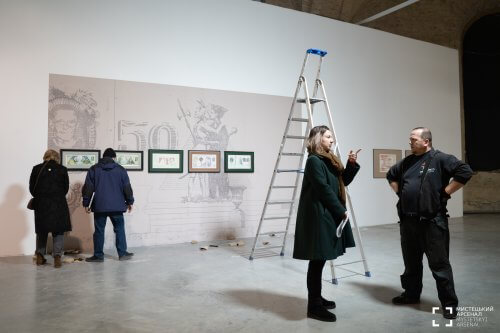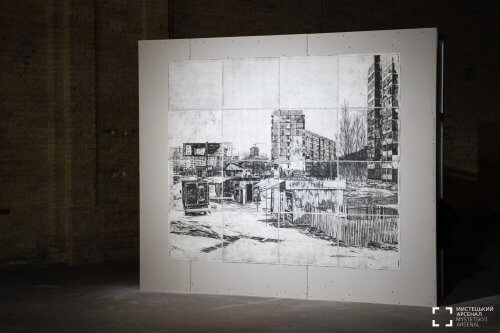DIVING INTO THE “IMPRINT”. GUIDELINE FOR VISITORS OF THE EXHIBITION ABOUT UKRAINIAN PRINTMAKING OF THE XX-XXI CENTURIES
A large-scale exhibition Imprint. Ukrainian printmaking of the XX-XXI centuries had to be presented at Mystetskyi Arsenal in March and later in June. However, due to the spread of the virus (SARS-CoV-2), as well as the government-implemented measures to suspend it, the exhibition was installed and dismantled twice.
During the quarantine, we prepared visitors for the exhibition — published videos from graphic workshops about various techniques and a guide for future visitors. The text below is not an attempt to transfer the exhibition to an online format, it is meant to serve as an additional information source and a guideline for future visitors of the Imprint exhibition.
On July 3, Mystetskyi Arsenal has finally opened the long-awaited exhibition.
The preparation to the exhibition has began almost two years ago — in the summer of 2018 — when the Program Board of Mystetskyi Arsenal selected the proposal from independent curators Kateryna Pidhaina and Iryna Borovets as a winner of the annual open contest of exhibition projects. Additionally, several others have joined the Imprint team as experts and advisors: Oleksandr Soloviov (Curator of Contemporary Art at Mystetskyi Arsenal), Olha Lahutenko (Doctor of Art Studies, Professor at National Academy of Fine Arts and Architecture, Kyiv), and staff members of the contemporary art and museum departments of Mystetskyi Arsenal.
“While 30-40 years ago, the art of printmaking mostly had a lot of utilitarian functions — to copy and share the information, to create posters, or to illustrate books, now these are served by other media. Printmaking moved to fulfill a purely artistic function. Besides, more and more artists make unique, limited edition printed works, and we are seeing a new development leap in the Ukrainian printmaking,”— co-curator Kateryna Pidhaina explained the relevance of the exhibition 👇
Imprint seeks to identify the relationships between and transformations of the artists, phenomena, and trends in Ukrainian printmaking from the early XX century to the present. Therefore, the curators and exhibition architects chose a non-linear structure of the exhibit — works from museum collections by renowned masters are displayed along with works of contemporary artists, demonstrating a one, meaningful field of different generations of printmaking artists, and the interrelations between them.
“We will show artworks from ten Ukrainian museums and several private collections. Many of these art pieces were never displayed to the public, and some works will be created specifically for the Imprint project”, adds co-curator Iryna Borovets 👇
Imprint exhibition consists of three thematical blocks, and the first is Looking for New Meanings. It highlights the intersections of topics, which were in focus and responded by the printmaking artists of independent Ukraine and those working in the early XX century. Experiments and the return to national traditions, a play with form and space, the maximum deviation from the realistic image — features that belong to both periods, and the adjoined display of works from the two different periods aims to visualize these commonalities.
Putting the works by Oleh Tistol from the Ukrainian Money series (1998-1999) on a display of Imprint exhibit.
Photo: Oleksandr Popenko © Mystetskyi Arsenal
Heorhiy Narbut and Oleh Tistol represent one of such “adjoined pairs” in this block. Working on the series Ukrainian Money (1998—2010), Oleh Tistol, whose oeuvre was formed in the finale of the Soviet paradigm collapse, appeals to the experience of Heorhiy Narbut, a prominent artist, who made banknotes sketches for Ukrainian money in the early XX century. The idea to create the sketches of banknotes, which in a sense are the main visual identification of the country, wasn’t based on imitation of Narbut’s artistic approach but was driven by the desire to be involved in the development process of a new Ukrainian state, being the author’s initiative. It was also based on a protest against the system as a whole and against the visuality, which was a characteristic of Soviet rubles in particular.
The contemporary urban landscapes of Taras Kovach and postmodern works from Intervention (2018) series by Iryna Kalenyk will share the united, meaningful space of the first block with Olena Kulchytska’s Hutsul Mother (1935) and Volodymyr Zauze’s Winter in Ukraine (1935). This block will feature 135 works by 45 authors in total.
From the “Noise” project, 2020, Taras Kovach. Etching, installation.
Photo: Oleksandr Popenko © Mystetskyi Arsenal
The second block, On the Verge of the Allowed, will cover the period from the 1950s through the 1980s. It will explore the questions of how and why the art of printmaking not only survived the isolation and Soviet censorship but also discovered unusual approaches to the composition and style, with non-trivial, original scenes within “allowed” topics.
Therefore, this block will reveal several unique artistic phenomena that have already become a part of Ukrainian art history. It will explain how the artists of the 1960s admired the Carpathians, what role did the landscape play, why did the book design become an avenue for free creativity, why and how did the printmaking techniques change, and some other topics.
The printmaking of the 1960s is truly a phenomenon of Ukrainian art. It was laconic, contrasting, and sometimes even austere. At the same time, the printmaking of those years can be characterized as maximally conventional, diverse in its subjects, approaches, and opportunities, provided by the linocut technique — the favorite one of the time. A tribute to the linocut was paid by all contemporary artists of those times without exceptions.
The triptych Toloka (1967) from the My Land series by Volodymyr Kutkin in the block On the Verge of the Allowed is the quintessence of the linocut technique of the 1960s. Looking at the monumental female images, one may not realize that the artist is showing the “beauty of work” of a Soviet person. In the 1970s and early 1980s, a period of new artistic language and the art of individualities began, the subjective structure was rethought, and a new formation began.
All works by Oleksandr Hubarev.
In Circus (1964), linocut, gouache on paper. The Sun, the Air, the Water (1962), linocut, watercolour on paper. Decorative Motif (1960), colour linocut on paper.
Hutsul Woman (1965), linocut, watercolour on paper. Kozak Mamay (1963), linocut, watercolour on paper.
Photo: Oleksandr Popenko © Mystetskyi Arsenal
The third block adopted its title from the definition of the iconic Ukrainian graphic artist Oleksandr Aksinin — Infinitive Graphics. This block is about art that strives to avoid any connections to a particular context, space, or time while staying aside from pressing social problems and processes. This concept sees art existing in a parallel reality with the system rather than in open opposition to it.
In the third block, artists whose works can be collectively referred to as the “unofficial art” of the Soviet times are presented. Among them are Vilen Barskyi, one of the first Kyiv conceptualists, and the guru of the alternative art from Zakarpattia — Pavlo Bedzyr. Artists of independent Ukraine are also presented in the Infinitive Graphics, including Konstantin Kalynovych, whose etchings immerse a viewer in nostalgia for the greatness of Dutch masters and their attention to details, and Oleg Denysenko, who is inspired by the aesthetics of the Middle Ages and creates new, chimerical worlds, which he calls Antiqvitas nova or “the new old”.
In addition, Imprint visitors will have an opportunity to see a real printmaking studio and imagine the complexity of this artistic process. The studio will function during printmaking workshops for the public.
While acknowledging all the risks caused by the coronavirus pandemic, the Mystetskyi Arsenal team began the installation of the Imprint exhibition on March 2. On March 16, Mystetskyi Arsenal started receiving the artworks requested from other museums, but very shortly, on March 18, the exhibition had to be dismantled and the works were put to the collection storage.


